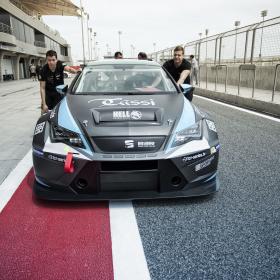
Chang International Circuit
Thaiföld
All about the circuit
The Chang International Circuit (ช้าง อินเตอร์เนชั่นแนล เซอร์กิต) (also Buriram United International Circuit) is a motorsport race track in Buriram, Thailand. The circuit was opened in 2014. This is the first FIA Grade 1 and FIM Grade A circuit in Thailand. The track's primary corporate sponsor is Chang Beer, named the track as part of the sponsorship.
The Japanese Super GT has visited Buriram since 2014. Also, the TCR International Series, TCR Asia Series and GT Asia Series is scheduled to race at Burinam in October 2015, and the World Touring Car Championship in November 2015, and the Asian Le Mans Series in January 2016.
On March 22 2015, the first ever Thailand round of the World Superbike Championship was held at the circuit. Both of the Superbike races were won by UK rider Jonathan Rea and the World Supersport race was won by Thai rider Rathapark Wilairot, much to the delight of the Thai spectators.
On June 23 2015 it was announced that the Porsche Carrera Cup Asia series would be visiting the circuit for the seventh and eighth rounds of the one-make series.
Guia Circuit
The Guia Circuit, or Circuito da Guia, is a street circuit located at the southeast region of the Macau Peninsula in Macau, China. It is the venue of the prestigious Macau Grand Prix and Guia Race of Macau. The circuit consists of long straights and tight corners, and features the characteristics of a typical street circuit - narrow, bumpy and limited overtaking opportunities. However, there are two special features that can rarely be found in other street circuits - variation in altitude (over 30m between highest and lowest point of the circuit) and an ultra long main straight that allows top speed of 260 km/h on F3 cars. As a result, the circuit is recognised as one of the most challenging circuits in the world in terms of both driving and tuning, as cars have to maintain competitive speed to overcome hill-climbing, twisty corners and long straights in a single lap.
History
The Guia Circuit was originally conceived in 1954 as a route for treasure hunt around the streets of the city, but shortly after the event it was suggested that the hunt's track could host an amateur racing event for local motor enthusiasts. Since 1967, with the introduction of a motorcycle race, the track has become a venue for both motorcycle and car racing events.
Layout
Unlike other regular racing tracks in the world, the layout of the Guia Circuit has not been modified since its first event in 1954 (the pit and paddock complex has been relocated to the present location since 1993, but the layout of the circuit has not been changed). The narrowest part of the track has a width of merely 7m, which is located at the Melco Hairpin. The whole length of the circuit is safely bounded by Armco barriers painted in black and yellow stripes. There used to be a gravel trap near the Reservoir Bend but since the pit and paddock complex was moved to the present location, this feature has been removed.
Racing events
The circuit is unique for its combination of motorcycle and car racing events within the same race weekend. The Macau Motorcycle GP, the Guia Race (WTCC final rounds from 2005 to 2014) and the Macau Formula 3 GP are the highlights of the race weekend. In addition, various kind of racing events are organized for competition between local and regional (Hong Kong, Taiwan, Japan, South East Asia, etc.) enthusiasts.
Grandstands
There are two major grandstands around the circuit for spectators to watch live racing - the main grandstand along the pit straight and the other one at the Lisboa Bend. The Lisboa Bend is the most famous spot of excitement as it offers the only possible overtaking opportunity at the end of the main straight. On the other hand, it is also notorious for massive pile-ups on opening laps due to its 90-degree turn configuration and its significant reduction in track width. As a result, the ticket price for a seat at the Lisboa Bend is much higher than that of a seat at the main grandstand. But as with most street circuits there are many people who stand or sit next to the track or on bridges and fly overs.



























